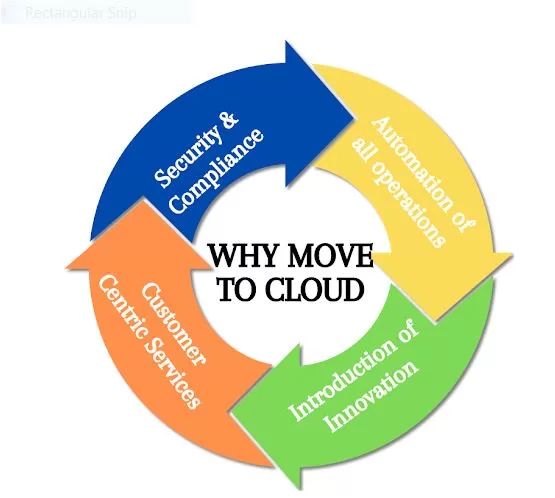Key Takeaways
- Cloud migration revolutionizes lending by reshaping operations for customer-centricity, innovation, and compliance, beyond cost reduction.
- Traditional systems’ adaptability, scalability, security, and responsiveness limitations are overcome through cloud migration, ensuring agility and competitiveness.
- Cloud adoption is vital for banks to stay relevant, requiring a fundamental transformation of lending operations to meet evolving demands and seize competitive opportunities.
The Game-changing Impact of Cloud Migration
The need for advanced technology is paramount in the swiftly evolving banking and finance landscape, marked by heightened customer expectations, constant innovation, and stringent regulatory demands. Banks and financial institutions are turning to the cloud as a pivotal differentiator to navigate these challenges.
Cloud migration allows banks and financial institutions to redefine their operational dynamics. It’s not just about reducing IT costs—though the potential for up to a 75% reduction is compelling —it’s about reimagining how financial entities operate, adapt, and innovate.
Cloud migration is more than a technological shift; it’s a holistic strategy for staying competitive, responsive, and innovative in the ever-changing lending landscape. It’s about embracing the future with a technology foundation that supports growth, resilience, and customer-centric excellence.
Overcoming Legacy Limits
Traditional lending systems, deeply rooted in legacy technologies, encounter formidable challenges that hinder adaptability to the dynamic financial landscape. Here, we unravel the limitations and shed light on why these systems face difficulties in sync with the rapid evolution of innovation and shifting industry requirements.
- Rigidity and Inflexibility: Legacy systems often struggle to adapt to rapid technological shifts and changing business requirements. Their rigid structures hinder the implementation of agile practices.
- Scalability Issues: As business volumes grow, traditional systems may face challenges in scaling efficiently to accommodate increased workloads. This can lead to performance bottlenecks and hinder seamless operations.
- Maintenance Cost: Legacy systems are associated with high maintenance costs. Outdated technologies may require specialized skills and resources for upkeep, making it financially fit for organizations.
- Security Concerns: Older systems may lack modern security features, leaving them more vulnerable to cyber threats. Keeping these systems secure requires additional investments and efforts.
- Integration Capabilities: Traditional systems often operate in silos, making integration with new technologies and applications challenging. This limitation inhibits the development of a unified and connected ecosystem.
- Long-time to Market: Because outdated operating models are spread across numerous systems, the time to market for new loan products and enhancements tends to be very slow.
- Continuous Innovations: Digital innovations are disrupting the marketplace, and the existing lending applications and other systems are not capable of taking advantage of new technologies.
- Customer Expectations: Legacy systems struggle to adapt to the dynamic expectations of customers seeking personalized lending solutions tailored to their specific needs.
Benefits of Cloud-native Lending
As the financial landscape continually transforms, traditional lending models face challenges in keeping pace with evolving customer expectations, industry demands, and the need for innovation. Cloud-native solutions have emerged as a powerful strategy for banks and financial institutions. Let’s explore the transformative benefits that cloud-native lending can bring to your institution.

- Scalable Growth: Enable dynamic expansion of lending operations, effortlessly adapting to evolving business needs and ensuring consistent performance.
- Cost-Efficient Solutions: Significant cost reductions by eliminating legacy applications and minimizing initial capital expenditure, leading to improved financial efficiency from the outset.
- Enhanced Security Standards: Specialized cloud Service Providers provide advanced security measures that surpass traditional standards and ensure robust protection for sensitive financial data.
- Agile Development and Deployment: Modern agility platforms allow for swift application development, testing, and deployment, accelerating the introduction of new loan products and reducing time-to-market.
- Reliability and Resilience: Distributed architecture enables reliability and resilience, replicating data and services across multiple locations to maintain operational continuity during disruptions.
- Seamless Integration and Operational Streamlining: Cloud transformation facilitates seamless interaction among various systems, leading to more efficient problem-solving and quicker customer issue resolution.
- Elevated Customer Satisfaction: Enhanced overall customer experience with quicker onboarding, closing times, and improved operational efficiency.
Realize the Promise of the Cloud
Traditional lending faces increasing pressure from disruptive players in the competitive landscape of banking and financial institutions. Lenders must go beyond automation and digitization to adapt, focusing on integrated offerings that enhance customer experiences. Embracing cloud technology is vital, providing scalability and real-time data processing capabilities. With a wealth of domain expertise in the cloud arena, Insight Consultants offers tailored cloud solutions, ensuring a seamless migration experience aligned with your objectives—partner with us for an efficient and worry-free cloud transition.
Contact our expert team at Insight Consultants to realize the promise of cloud.





